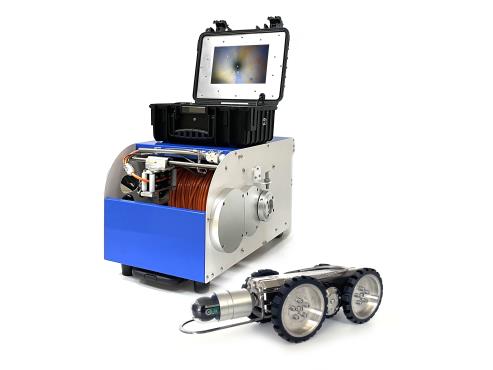Petrochemical pipelines are vital for transporting essential materials, making their integrity crucial for safety and efficiency. Regular inspections prevent leaks, environmental hazards, and operational disruptions, ensuring compliance with safety regulations. This blog explores three key inspection methods—video pipe inspection, ultrasonic testing, and magnetic flux leakage—highlighting their suitability for different scenarios. We will also delve into the benefits of video pipe inspection and introduce JIUTAI Technology, a leading provider of advanced video inspection solutions.
The Importance of Petrochemical Pipeline Inspection
Ensuring the safety and efficiency of petrochemical pipelines is critical for both environmental protection and operational reliability. Regular inspections play a pivotal role in pipeline integrity management, preventing potential disasters, and optimizing performance.
Preventing Leaks and Environmental Hazards
Routine inspections help detect and address issues such as corrosion, cracks, and leaks early, preventing hazardous materials from contaminating the environment and causing significant damage.
Inspecting gas pipelines presents unique challenges due to the high pressure and flammable nature of the gas, requiring specialized techniques and tools.
Ensuring Operational Efficiency and Reducing Downtime
By identifying and fixing problems before they escalate, inspections minimize unplanned shutdowns and maintenance costs, ensuring smooth and continuous operations. Utilizing inspection data, companies can analyze and interpret the condition of pipelines, informing comprehensive reports that highlight concerns and suggest maintenance strategies.
Complying with Safety Regulations and Standards
Regulatory compliance through regular inspections not only safeguards the company’s reputation but also avoids legal penalties and ensures the safety of workers and the surrounding community.
3 Main Methods of Petrochemical Pipeline Inspection
To ensure the integrity and safety of petrochemical pipelines, several inspection methods are employed. Each method has its unique strengths and is suitable for different scenarios, making it essential to choose the right one based on specific inspection needs. Comprehensive pipeline inspection services utilize advanced technologies to identify issues like corrosion and mechanical damage, ensuring optimal pipeline efficiency by removing debris and other deposits.
Video Pipe Inspection
Video pipe inspection utilizes advanced camera technology to provide real-time visual assessments of the internal condition of pipelines. This method is particularly suitable for detecting internal corrosion, blockages, and structural damage. It is ideal for routine inspections and maintenance checks, allowing for non-intrusive and detailed evaluations. Our extensive offerings in video inspection services are designed to address various integrity management concerns, utilizing diverse technologies to tackle issues such as corrosion and mechanical damage.
Ultrasonic Testing
Ultrasonic testing employs high-frequency sound waves to measure wall thickness and detect internal flaws within the pipe material. This method, often used in in-line inspection, is highly effective for inspecting welds and identifying internal defects that may not be visible on the surface. It is best suited for applications where precise measurements of material integrity are required.
Magnetic Flux Leakage (MFL)
Magnetic flux leakage involves magnetizing the pipeline and detecting disruptions in the magnetic field caused by corrosion, pitting, and cracks. This method is particularly suitable for rapid scanning of large pipeline sections, making it ideal for identifying and assessing corrosion in ferromagnetic pipelines. MFL is a powerful tool for detecting early signs of degradation before they lead to significant issues. Magnetic particle inspection is also highly effective in identifying critical flaws such as cracks and weld discontinuities in ferromagnetic materials, using various techniques tailored to the specific material and defect type.
What Is Video Pipe Inspection?
Video pipe inspection employs high-resolution cameras mounted on flexible, remotely controlled devices. These devices navigate through the interior of pipelines, capturing detailed video footage. The cameras can be equipped with various lighting and zoom capabilities to enhance visibility and provide clear images of the pipeline's condition. The collected inspection data is crucial for analyzing the pipeline's state and determining appropriate maintenance strategies.
Steps Involved in the Inspection Process
- Preparation: The pipeline section to be inspected is selected and prepared, ensuring access points are available.
- Insertion: The video inspection device is inserted into the pipeline via an access point.
- Navigation: The device is remotely navigated through the pipeline, capturing continuous video footage.
- Data Collection: Real-time video data is transmitted to the inspection team, who monitor and record the footage.
- Analysis: The recorded footage is analyzed to identify any issues such as corrosion, blockages, or structural damage.
- Reporting: A detailed report is generated, highlighting the findings and recommending necessary maintenance actions.
Types of Issues It Can Detect
- Internal corrosion and rust
- Cracks and fractures in the pipe walls
- Blockages and obstructions
- Joint and weld integrity issues
- Structural deformities and collapses
- Leaks and seepage points
Benefits of Using Video Pipe Inspection Over Other Methods
Video pipe inspection offers numerous advantages that set it apart from other pipeline inspection methods. Its unique capabilities make it an essential tool for ensuring the integrity and safety of petrochemical pipelines. Below, we explore the key benefits of video pipe inspection and why it is a preferred choice for many operators.
Comprehensive pipeline services, including in-line inspection and integrity services, are crucial for managing pipeline reliability and facilitating processes such as startup and decommissioning.
Non-Intrusive
It minimizes the need for pipeline shutdowns and disruptions.
Video pipe inspection allows for thorough internal evaluations without the need to halt pipeline operations. This non-intrusive method ensures that inspections can be carried out while the pipeline remains in service, minimizing downtime and maintaining the flow of operations. This is particularly beneficial for industries where continuous operation is crucial and any interruption can lead to significant financial losses.
Real-Time Data
It provides immediate visual feedback, allowing for prompt decision-making.
One of the standout advantages of video pipe inspection is the ability to capture and transmit real-time video footage. This immediate visual feedback enables inspectors and maintenance teams to quickly identify and assess issues as they arise. Prompt decision-making can be made regarding necessary repairs or maintenance actions, reducing the risk of small problems escalating into major issues.
Comprehensive Detection
Capable of identifying a wide range of issues with high accuracy.
Video pipe inspection is highly versatile, capable of detecting various internal pipeline issues with great accuracy. It can identify corrosion, cracks, blockages, leaks, joint and weld integrity issues, and structural deformities. This comprehensive detection capability ensures that no potential problem goes unnoticed, providing a thorough assessment of the pipeline’s condition.
Cost-Effective
It reduces the need for extensive exploratory excavation and repair.
Traditional inspection methods often require extensive excavation and physical inspection, which can be costly and time-consuming. Video pipe inspection reduces the need for these exploratory measures by providing a clear view of the pipeline's interior. This not only saves on labor and material costs but also allows for more targeted and efficient repairs, addressing only the areas that need attention.
Enhanced Safety
It limits the exposure of inspection personnel to hazardous environments.
Safety is a paramount concern in petrochemical pipeline operations. Video pipe inspection significantly reduces the need for personnel to enter potentially hazardous environments. By using remotely controlled inspection devices, the exposure of workers to dangerous chemicals, high-pressure environments, and confined spaces is minimized. This enhances overall safety and reduces the risk of accidents and health issues among inspection personnel.
JIUTAI Technology: Leaders in Video Pipe Inspection Solutions
JIUTAI Technology offers a comprehensive range of video pipe inspection products designed to cater to various inspection requirements. The product lineup includes high-resolution inspection cameras, remotely controlled inspection robots, and versatile pipeline crawlers. These products are engineered to provide detailed visual assessments of pipelines, ensuring thorough and accurate inspections. Additionally, JIUTAI's technology is well-suited for remote pipeline inspections, utilizing advanced monitoring systems that can operate efficiently in hazardous areas and remote locations where traditional energy sources may not be feasible.
Features and Benefits of JIUTAI’s Inspection Equipment
High-Resolution Cameras: JIUTAI inspection cameras offer exceptional image quality, enabling clear visualization of even the smallest pipeline defects. The high-resolution footage provides detailed insights into the pipeline's condition, facilitating precise assessments and decision-making.
Remote Control and Navigation: JIUTAI’s inspection robots and crawlers are equipped with advanced remote control and navigation capabilities. This allows operators to maneuver the inspection devices through complex pipeline networks with ease, ensuring comprehensive coverage and minimizing manual intervention.
Durability and Reliability: Built to withstand harsh environments, JIUTAI’s inspection equipment is highly durable and reliable. Their robust construction ensures consistent performance even in challenging conditions, making them suitable for a wide range of inspection scenarios.
Versatility: JIUTAI’s product range is designed to accommodate various pipeline sizes and types. Whether inspecting small diameter pipes or large industrial pipelines, JIUTAI’s equipment delivers consistent and accurate results.
User-Friendly Interface: JIUTAI’s inspection systems feature intuitive interfaces that simplify operation and data analysis. The user-friendly design ensures that operators can efficiently conduct inspections and interpret results, enhancing overall productivity.
With their advanced technology and unwavering dedication to quality, JIUTAI Technology provides pipeline operators with the tools they need to ensure the safety, reliability, and efficiency of their petrochemical pipelines.
Conclusion
Regular and thorough inspection of petrochemical pipelines is crucial for maintaining their integrity, safety, and efficiency. By employing advanced methods such as video pipe inspection, ultrasonic testing, and magnetic flux leakage, pipeline operators can effectively identify and address potential issues before they escalate. These inspections are a key component of pipeline integrity management, ensuring pipelines are in optimal condition and compliant with safety regulations. Among these methods, video pipe inspection stands out for its non-intrusive nature, real-time data capabilities, and comprehensive detection of a wide range of issues. Investing in regular pipeline inspections and utilizing cutting-edge technologies like those offered by JIUTAI Technology is essential for ensuring the continuous and safe operation of petrochemical pipelines.






